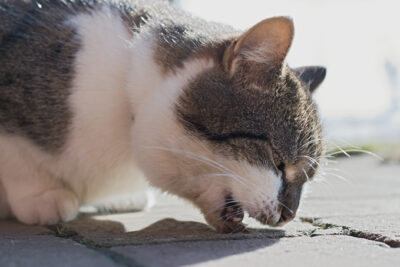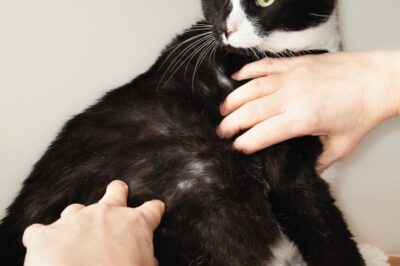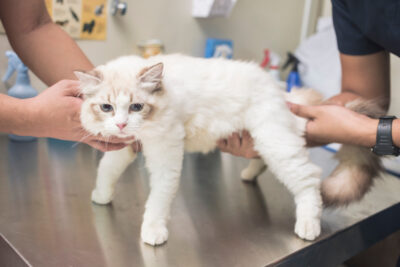What Colors Can Cats See?

Can cats see color? There was a time when people thought cats couldn’t see any color at all, believing felines only viewed the world in shades of gray. But in the 1960s, that perception was turned on its head. Scientists realized that cats could see some color, and that their visual capacities were much more complex than previously thought (1).
While cats see fewer colors than humans, they have extra visual abilities that we lack. For instance, cats can see quite well in the dark!
So what colors can cats see? To understand cat color perception, it’s helpful to know how their eyes are structured. Here’s what you need to know about cat vision.
Cat Vision: Understanding Feline Eye Anatomy

There are many similarities between human eyes and cat eyes, at least in the anatomical sense, says Dr. Kelli Ramey, a veterinary ophthalmologist and owner of Calgary Animal Eye Care in Calgary, Canada.
“We have all the same basic structures: the cornea, the clear windshield of the eye; the iris, the colored part of the eye; a lens; and a retina,” says Ramey. “Probably the predominant anatomic difference between our eyes and cats’ eyes is the shape of the pupil. So that cat eye has that vertical slit-shaped pupil, which actually helps them with more of their distance vision, and it can improve their visual acuity at a distance.”
A critical difference between humans’ and cats’ eyes lies in the composition of the retina—namely, the photoreceptor cells known as cones and rods. Human eyes have more cones, enabling broad color vision. Cat eyes mainly consist of rods that allow for black-and-white vision in dim light. While cats do have cones that allow them to see color, their visual abilities focus more on seeing in the dark rather than distinguishing a range of colors.
“Cats can see better in the dark than we can largely because they have more rods than cones and a greater density of rods than we have,” says Dr. Riley Aronson, an ophthalmology research fellow at University of Florida College of Veterinary Medicine. “This helps them hunt in darker lighting, since cats are technically crepuscular (most active at dawn and dusk). Another reason they see better in the dark is because cats (excluding blue-eyed cats) have another layer in the back of their eye called a tapetum lucidum—or tapetum for short. This helps reflect light back through the retina, meaning the photoreceptors (rods and cones) receive more light.”
While cats are known to have two types of cones in their retinas, some recent studies have suggested that cats could have a third cone, allowing them to see a broader spectrum of color (2). But this idea is controversial since these cones cannot be consistently detected in anatomic or behavioral studies of vision in cats (3).
What Colors Can Cats See?

There is still a lot to learn about feline vision, but most experts agree that cats see shades of blue-violet and yellow-green. On the other hand, cats cannot see red, orange, and brown hues.
So does that mean cats can’t see the laser pointer’s red dot? Aronson says cats can see the laser, just not the color.
“It is the movement of the dot that they see, rather than the color,” says Aronson. “Cats are similar to people with red-green colorblindness and are thought to perceive red objects as green.”
Cats may respond more favorably to objects within their color range, says Ramey.
“If we want to play to the strengths of cats’ color vision, buying them toys and beds … that are in that blue to yellow-green color range just means that they’re going to potentially find things more easily,” says Ramey. “If you’re throwing a ball and it’s red, it’s going to be harder for them to find and track compared to a blue ball.”
Do Cats See Color the Same Way as Dogs?

Cats see color in a similar way to dogs, but there are some crucial differences between cat and dog vision.
“Dogs are a little bit more toward that blue and strong yellow, whereas cats [see] a little bit more blue and greenish-yellow,” says Ramey. “It’s not a huge difference, but it’s small enough that it’s noted in the research.”
Another distinction is that dogs have better visual acuity than cats. “Things will actually look a bit more blurry to cats,” Ramey explains.
Cat vision might be more “blurry,” but they have excellent motion detection – better than dogs do. And cats can see well in the near dark. However, cats are more near-sighted than dogs, and can only see about 20 feet in front of them.
“Evolutionarily, this makes sense for them,” says Aronson. “They hunt when it’s darker and hunt close up. The vertical pupil helps them hunt from trees and higher distances.” They are experts at tracking moving prey.
Color Blindness in Cats

Is it possible that some cats are colorblind? Ramey says it’s impossible to know.
“Since individual cats can’t communicate exactly what they see from cat to cat,” says Ramey, “I don’t think we know for sure. We know more generalities.”
Aronson takes a similar view: “I think colorblindness would be hard to diagnose in cats since we can’t see that they’re struggling with crayons in elementary school, for example.”
That said, Aronson says some medical issues could impact a cat’s vision as a whole. “Anything that degrades the retina itself,” says Aronson. “For cats, these diseases include retinal degeneration, PRA (progressive retinal atrophy), taurine deficiency in the diet, fluoroquinolone (an antibiotic class) toxicity, and retinal detachment.”
While color blindness hasn’t been recognized in cats, experts say cats see color in a comparable way to humans with red-green color blindness.
“Probably the closest we can perceive to what cats see in color would be for like a colorblind person,” says Ramey.
Conclusion
In summary, cats can see color, but not in the same way as humans, or even dogs. Most experts believe their vision is limited to shades of blue-violet and yellow-green, and that they’re unable to see hues of red, orange, and brown.
What cats lack in color vision, however, they gain in night vision and motion detection. In other words, don’t underestimate what your cats can see.









